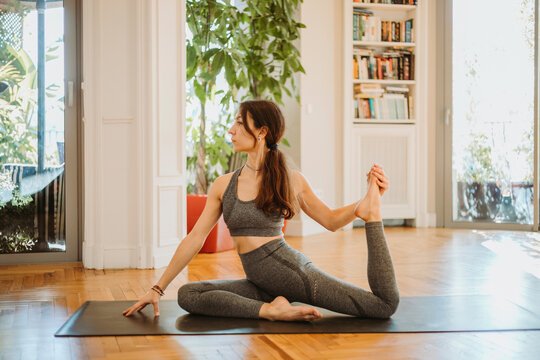Yoga bands are easy tools that help make any yoga or fitness routine more challenging. People use them to build strength and improve balance without needing heavy weights or big equipment. Yoga bands add resistance to moves, which makes muscles work harder and helps the body get stronger and steadier.

Anyone from beginners to experienced yogis can use yoga bands to boost their workouts. They are simple to use and can be added to many exercises. With the right techniques, yoga bands can make a big difference in strength and balance over time.
Key Takeaways
- Learn what yoga bands are and how to use them.
- Find tips for safe and effective workouts.
- Get answers to common questions about yoga bands.
Essential Techniques for Using Yoga Bands
Yoga bands can help improve muscle strength and body control. They also make balancing exercises easier to learn and safer to practice.
Choosing the Right Yoga Band
It is important to choose a yoga band that matches your fitness level and workout goals. Light-resistance bands are best for beginners, people recovering from injury, or those focusing on rehab. Medium-resistance bands work well for most balance and strength training exercises. Heavy-resistance bands are for advanced users who need extra tension for strength building. Here are some recommended products.
Material matters: Look for bands made from high-quality latex or fabric for durability. Test the length and width before buying. Most bands range from 3 to 6 feet; longer bands allow for more movement. Shorter bands feel tighter and are good for isolated muscle work.
Check for any tears, worn spots, or weak areas before using a band. Buying a set of bands with different levels of resistance can help users progress and target different muscle groups.
Basic Band Positions and Grips
Proper hand and foot placement on the band keeps exercises safe and effective. Standing on the band while holding the ends is a common way to add resistance for squats or side steps. To train arm strength, wrap the band around your palms, grip it tightly, and keep your wrists straight.
Seated or floor positions allow for pulling exercises. For example, sit with legs extended, loop the band around your feet, and pull the ends towards your chest to work the back and arms.
A table of common grips:
| Exercise | Position | Grip Type |
|---|---|---|
| Bicep Curl | Standing | Palms face up |
| Row | Seated | Overhand grip |
| Side Leg Lift | Lying on side | Band above knees |
Always keep some tension in the band before starting to avoid snapping or slippage.
Safety Tips for Strength and Balance Training
Inspect yoga bands before every session. Never use a band with cracks or thin spots, as it might break during use. Clear the workout space of any objects that could cause tripping or falling.
Start with bands that feel manageable. Do not use a band with more resistance than can be safely handled. Keep movements slow and controlled. Fast, jerky actions increase the chance of losing balance or control of the band.
Wear shoes with a non-slip sole if standing. When looping the band around feet or hands, make sure it is secure and won’t slip off suddenly. Never stretch the band beyond twice its original length to prevent snapping.
If experiencing pain or discomfort (not muscle fatigue), stop and check technique or resistance level. Stay focused and avoid distractions during training.
Strength and Balance Workouts With Yoga Bands
Yoga bands add resistance and support to a practiced routine. They can help people build muscle, improve balance, and focus on good posture.
Core and Stability Exercises
Yoga bands are helpful for targeting the core muscles. One useful move is the Seated Band Twist, where a person sits with legs straight and wraps the band around their feet. Holding the ends, they twist side to side, feeling their obliques work.
Plank with Band Pulls is another strong choice. From a plank position, they anchor the band under one palm and pull with the other hand out to the side. This strengthens the abs, shoulders, and back while challenging balance.
A short list of key core moves includes:
- Seated Band Twist
- Plank with Band Pulls
- Bicycle Crunches with band around feet
Each exercise helps with both stability and strength.
Lower Body Strengthening Movements
Yoga bands make lower body workouts more challenging. In a Squat with Band, the band is placed above the knees. As the person squats, the band works the thighs harder and keeps the knees from caving in.
Another option is the Banded Glute Bridge. With the band around the thighs, the person lifts their hips, squeezing the glutes and resisting the urge for the knees to fall in. This move supports hip strength and helps with everyday balance.
Try these moves as well:
| Exercise | Band Placement | Main Muscles Used |
|---|---|---|
| Squat with Band | Above knees | Quads, glutes |
| Lateral Band Walks | Around ankles | Hip abductors |
| Glute Bridge | Above knees | Glutes, hamstrings |
Bands provide gentle but effective resistance for the legs.
Upper Body Balance Drills
For the upper body, yoga bands allow for push and pull exercises that require good alignment. In a Standing Row, the person steps on the band and pulls back with both arms. This activates the back, shoulders, and core.
A Single Arm Band Press involves pressing one end of the band overhead while standing tall, which challenges balance because the band tries to pull the body sideways.
Here are a few upper body drills:
- Standing Row
- Single Arm Band Press
- Chest Press with Band behind back
Focusing on slow, steady movements helps build both strength and control. These drills can be done at home or in a class.
Frequently Asked Questions
Yoga bands can help build muscle, improve balance, and support a strength routine at home. Safe use and exercise choice are important for the best results.
What are some beginner-friendly exercises with yoga resistance bands?
Beginners can start with seated rows, banded squats, and standing side steps.
Simple bicep curls and overhead presses using the band are also beginner-friendly.
These exercises can help someone get comfortable with the bands and learn basic movements.
Can resistance bands be effective for improving overall balance?
Resistance bands can help improve balance by adding controlled resistance to standing exercises.
Moves like single-leg deadlifts or standing hip abductions challenge stability and body control.
Training with bands often requires activating core and stabilizer muscles.
How can one incorporate yoga bands into a strength-training routine at home?
They can be added to exercises like lunges, chest presses, or glute bridges.
Users can anchor the band under their feet or to a door for variety.
Bands allow for progressive resistance without needing heavy equipment.
Are there specific resistance band exercises that target belly fat reduction?
No exercise will directly remove fat from only the belly area.
Resistance band exercises such as wood chops, Russian twists, and plank band pulls can strengthen and tone the core muscles.
Combined with cardio and a healthy diet, these moves may help reduce overall body fat.
What are the steps to safely use yoga bands for enhancing muscle tone?
Start with a band that matches one’s fitness level to avoid injury.
Check the band for tears before each use, and secure it firmly when anchoring.
Move slowly and keep good posture throughout each exercise.
Is it possible to achieve a full-body transformation using only resistance bands?
Resistance bands can help improve strength, flexibility, and muscle tone in most major muscle groups.
Consistent use and challenging routines are important.
Results depend on effort, exercise selection, and overall lifestyle, including nutrition and rest.

